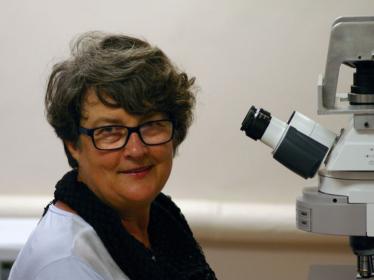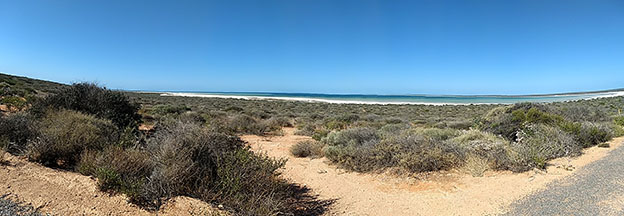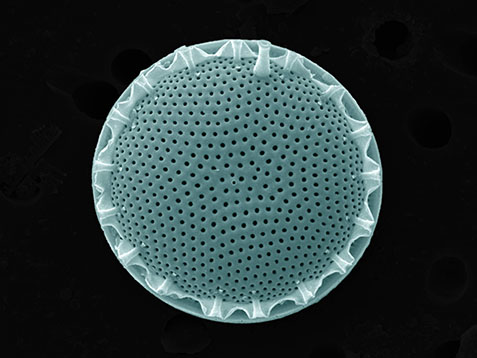Irena Kaczmarska

Publications
Selected publications:
Kaczmarska, I., J. M. Ehrman & B. Samanta, 2025. Oligocene archaeomonad stomatocysts from the Polish Central Paratethys. Acta Palaeontologica Polonica 70: 385-410.
Kaczmarska, I., J. M. Ehrman & B. Samanta, 2025. Auxospore structure and development in Toxarium sp. Nova Hedwigia 120: 577-590.
Kaczmarska, I. & J.M. Ehrman. 2024. Silicoflagellates and other siliceous micro- and nannofossils from Rupelian diatomites, southeastern Poland. Plant and Fungal Systematics 61:1-14.
Kaczmarska, I. & J.M. Ehrman. 2023. Parmalean and other siliceous nannofossils from the Oligocene Flysch Carpathians. Acta Palaeontologica Polonica 68: 441-456.
Kaczmarska, I., J.M. Ehrman & M.P. Ashworth. 2022. Sexual reproduction and auxospore development in the diatom Biddulphia biddulphiana. PLoS ONE 17: e0272778.
Kaczmarska, I., J.M. Ehrman, K.E. Mills, S.G. Sutcliffe & B. Samanta 2022. Vegetative cell enlargement in selected centric diatom species - an alternative way to propagate an individual genotype. European Journal of Phycology 58: 315-332.
Kaczmarska, I. & J.M Ehrman. 2021. Enlarge or die! An auxospore perspective on diatom diversification. Organisms Diversity & Evolution 21: 1-23.
Kaczmarska, I., J.M. Ehrman, N.A. Davidovich, O.I. Davidovich & Y.A. Podunay. 2020. Valve morphogenesis in selected centric diatoms. Botany 98: 725-733.
Samanta, B., I. Kaczmarska & J.M. Ehrman. 2020. Auxosporulation in Biddulphia tridens (Ehrenb.) Ehrenb. (Mediophyceae, Bacillariophyta). European Journal of Phycology 55: 296-309.
Kaczmarska, I., B. Samanta, J.M. Ehrman & E.M.A. Porcher. 2019. Auxosporulation in Chaetoceros acadianus sp. nov. (Bacillariophyceae), a new member of the Section Compressa. European Journal of Phycology 54: 206-221.
Samanta, B., J.M. Ehrman & I. Kaczmarska. 2018. A consensus secondary structure of ITS2 for the diatom Order Cymatosirales (Mediophyceae, Bacillariophyta) and reappraisal of the order based on DNA, morphology, and reproduction. Molecular Phylogenetics and Evolution 129: 117-129.
Samanta, B., Q. Heffell, J.M. Ehrman & I. Kaczmarska. 2018. Spermatogenesis in the bipolar centric diatom Plagiogrammopsis vanheurckii (Mediophyceae). Phycologia 57: 354-359.
Davidovich, N.A., O.I. Davidovich, Y.A. Podunay, R. Gastineau, I. Kaczmarska, A. Poulíčková, & A. Witkowski. 2017. Ardissonea crystallina has a type of sexual reproduction that is unusual for centric diatoms. Scientific Reports 7: 14670.
Kaczmarska, I., B.S. Gray Jr., J.M. Ehrman & M. Thaler. 2017. Sexual reproduction in plagiogrammacean diatoms: first insights into the early pennates. PLoS ONE 12: e0181413.
Samanta, B., M.E. Kinney, Q. Heffell, J.M. Ehrman & I. Kaczmarska. 2017. Gametogenesis and auxospore development in the bipolar centric diatom Brockmanniella brockmannii (Family Cymatosiraceae). Protist 168: 527-545.
Gastineau, R., G. Hansen, N.A. Davidovich, O. Davidovich, J.-F. Bardeau, I. Kaczmarska, J. Ehrman, V. Leignel, Y. Hardivillier, B. Jacquette, M. Poulin, M. Morançais, J. Fleurence & J.-L. Mouget. 2016. A new blue-pigmented hasleoid diatom, Haslea provincialis, from the Mediterranean Sea. European Journal of Phycology 51:156-170.
Luddington, I.A., C. Lovejoy & I. Kaczmarska. 2016. Species-rich meta-communities of the diatom order Thalassiosirales in the Arctic and northern Atlantic Ocean. Journal of Plankton Research 38: 781-797.
Kaczmarska, I. & J.M. Ehrman. 2015. Auxosporulation in Paralia guyana MacGillivary (Bacillariophyta) and possible new insights into the habit of the earliest diatoms. PLoS ONE 10: e0141150.
MacGillivary, M.L. & I. Kaczmarska. 2015. Paralia (Bacillariophyta) stowaways in ship ballast: implications for biogeography and diversity of the genus. Journal of Biological Research-Thessaloniki 22: 2.
Kaczmarska, I. & J.M. Ehrman. 2015. High colonization and propagule pressure by ship ballast as a vector for the diatom genus Pseudo-nitzschia. Management of Biological Invasions 6: 31-43.
Edgar, R., D. Drolet, J.M. Ehrman & I. Kaczmarska. 2014 Motile gametes of the araphid diatom Tabularia fasciculata search randomly for mates. PLoS ONE 9: e101767.
Education
M.Sc. Jagellonian University (Krakow) Aquatic Biology
Ph.D. Jagellonian University (Krakow) Botany
Teaching
Undergraduate and Graduate Courses
Biol 4951 - Independent Study in Biology: ecology of marshland and mudflat diatoms.
Biol 4950 - Independent Study in Biology: ecology of marine diatoms and other protists.
Biol 4990 - Honours Thesis: reproductive biology of diatoms (see current projects below).
Biol 5393 - Graduate Level Topics in Biology: evolution and ecology of marine diatoms.
Research
- Evolution of Diatoms: developmental, molecular and fossil evidence (NSERC, with B. Samanta)
- Application of artificial intelligence and other computing techniques in biological imaging (with J. M. Ehrman, Digital Microscopy Facility, NBIF)

Research Opportunities
Biological Science
1. Sex and reproduction in diatoms.
Recent molecular phylogenies often indicate that general similarity in diatom species appearance does not correlate with their evolutionary relatedness. More conserved characters, such as sex cell development and reproductive processes may be better predictors of common evolutionary roots. Unfortunately, no more than a few percent of diatom species have had any aspect of their sexuality examined. The aim of the project is to address this gap in knowledge using molecular developmental and morphological approaches.
Paleoenvironmental Science
2. Diversity and ecology of the Oligocene diatoms.
Extant species of many members of the diatom class Mediophyceae (e.g., Cymatosirales) have relatively weakly silicified frustules which results in their poor fossilization and thus poor understanding of their evolutionary history. The sedimentary environment from the Oligocene Carpathian Flysch facilitated exceptionally good preservation and rich flora of such species. Both diversity and paleoecological setting of these species during the Early Oligocene will be investigated and results will be placed in the context of the environment where their closest relatives thrive today.
Please contact I. Kaczmarska (iehrman@mta.ca) regarding the projects and Graduate Studies (https://mta.ca/admissions/how-apply/graduate-students-admissions) regarding admission.






